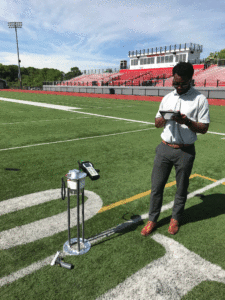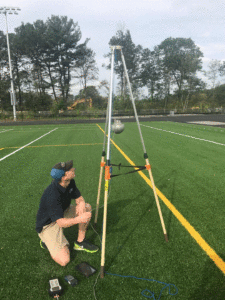The Field Tests Used to Determine Impact Resilience

Concussions are a hot topic in today’s sports world, and when it comes to synthetic turf fields, player safety is top priority. Synthetic turf playing surfaces may change as a result of turf fiber wear, infill displacement, and/or infill compaction. To monitor the playing surfaces and gauge performance requirements, fields can be periodically tested. The two field tests recognized in the athletic industry for determining impact resilience are GMAX, and Head Impact Criterion (HIC) testing.
Both the GMAX and HIC tests measure impact attenuation, or the amount of force a playing surface absorbs upon impact. Higher test values mean the playing surface is absorbing less impact and returning more force to the athlete, which can result in lower extremity injuries or concussions. The GMAX test, which uses a flat circular missile to measure body impact, has been used as the standard test for many years. However, the industry is looking to make HIC testing a standard in the near future. The HIC test uses a rounded spherical weight to represent the force of a human head impacting a playing surface. As such, the industry appears to be looking towards the HIC test as a standard to gauge the potential for concussions.

There are various ways to reduce impact and increase safety, including variations of the turf profile and infill system, as well as installing shock absorbing pads beneath the synthetic turf. Infill systems and shock pads can directly affect the GMAX and HIC test results because of their ability to absorb force upon impact. Whether you are considering replacing your turf carpet or infill system, installing a shock pad, or you simply have an aging field that needs testing, Gale now offers HIC and GMAX testing services.
Gale Associates, Inc. can provide additional information to support your decisions.
Tagged In:
Athletic Facilities Planning & Design
